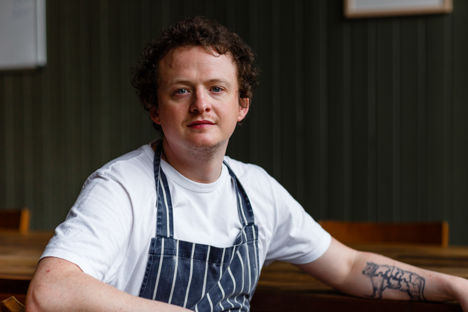
Ones to watch: James Murray
Edinburgh Food Studio may seem simple on the surface, but behind the scenes lies a chef with a serious pedigree. James Murray spent three years at Le Manoir before embarking on a career that took him to acclaimed Michelin-starred restaurants like Roussillon in Chelsea, Nur in Hong Kong and Lyle’s in Shoreditch.
Ones to watch: James Murray
Edinburgh Food Studio may seem simple on the surface, but behind the scenes lies a chef with a serious pedigree. James Murray spent three years at Le Manoir before embarking on a career that took him to acclaimed Michelin-starred restaurants like Roussillon in Chelsea, Nur in Hong Kong and Lyle’s in Shoreditch.
View more from this series:
Ones to watch‘It’s miserable up here man, it’s cold and it’s super wet. It’s a nightmare. It’s all good, though – Scotland, isn’t it?’
Edinburgh can be unpleasant during the winter months, but there’s more than a bit of excitement around the food scene in the Scottish capital these days. Falkirk-born James Murray is no stranger to the Scottish climate, but he can be forgiven for lamenting the northern winters – this is, after all, a chef who once worked for Richard Branson on his private island in the Caribbean. In the end, it took something special to bring him back to the perma-cold and rain of Edinburgh; the chance to take over the kitchen at Edinburgh Food Studio – one of the capital’s most invigorating new restaurants.
‘I’ve been here since August last year,’ James explains. ‘We’ve been pushing to find our identity since then really – we’re definitely getting there, but there’s still a lot more to achieve here.’
James has worked in kitchens all over the world but he grew up in Falkirk – a town almost equidistant between Edinburgh and Glasgow. It was never his intention to become a chef, he says, but food was a consistent presence in his childhood. ‘We always gathered around the table for meals and we ate well,’ he shrugs. ‘I just fell into cooking at an early age really – my dad’s friend had a restaurant at the top of my road so I started cooking there when I left school.’ The two AA rosette restaurant – Glenskirlie Castle – was just five minutes’ walk from James’ front door, and proved to be the perfect foundation for his career. ‘If I had just been working in any old restaurant,’ he says, ‘I don’t know where I would have ended up, honestly. Luckily they took the business seriously, so I did too.’
James spent three years at Glenskirlie before his jetsetting tendencies reared their head for the first time. As a fresh-faced nineteen-year-old he traded Falkirk for Tuscany, flying over a thousand miles to take a job in a small luxury hotel restaurant. ‘It was a British kitchen so the language barrier wasn’t so bad,’ he says, ‘but everyone else spoke Italian, so I had to learn a bit. I knew all the swear words and how to get home drunk, enough to survive, you know?’ The kitchen itself was extremely well organised – run by a chef from Gordon Ramsay’s recently closed Amaryllis in Glasgow – and the step up in intensity had James hooked. ‘It gave me the bug,’ he says. ‘When I finished in Italy I knew I wanted to go back to the UK and work somewhere at the highest level.’ He applied to restaurants all over the country, and heard back from two men who would change his life – Raymond Blanc and Gary Jones at Le Manoir aux Quat'Saisons.
Over the course of three years, James learnt everything there was to learn at Le Manoir and Raymond Blanc’s unique approach made a huge impression on him. ‘I basically started all over again,’ he says. ‘I went back to being very junior and worked every section. I went there with the idea that it would be a lot of middle-aged men in tall hats, but it wasn’t like that at all; it was a bit like going to university – everyone was my age, loved cooking, loved partying.
‘The way they cook there just agreed with me,’ he continues. ‘Le Manoir is a classical French restaurant, but the lightness of touch that Raymond brings to his food is very unique – I think because Raymond is self-taught, he’s always questioning things and that’s why Le Manoir is what it is.’
James left the venerable institution with a completely new worldview of food and spent the next few years working his way around London. He spent time with the Gordon Ramsay Group, at Texture with former Le Manoir head chef Agnar Sverrisson, and then at Roussillon with Alexis Gauthier. ‘We were there for a year and a half,’ he says. ‘He was the head chef and I was his number two.’ Roussillon was a firm favourite in Chelsea and held a Michelin star for ten years, but the pressure of running the restaurant in the increasingly difficult economic climate became too much. ‘We were too young to be running that restaurant,’ James admits. ‘I was twenty-five, he was twenty-four – just too young to be running a fine dining restaurant in Chelsea.’
The pair ran Roussillon until the lease came up in 2010 and then left, but not without baggage. James had been working solidly in kitchens for nearly ten years of his life already and suffered with considerable burnout. ‘I realised I was twenty-five, didn’t have friends or a girlfriend, didn’t have any of the things that people normally have.’ Disillusioned with the industry, he stepped away and took a job in a lawyers’ office, whilst continuing with a few pop-ups. ‘It let me pay the bills but still have a bit of fun,’ he explains. ‘I met new people, broadened my social skills. You don’t actually realise until you step away that you’ve learned a lot and you have your own style.’
Liberated, James used his skills to travel the world. He spent six months in Chicago consulting on a restaurant opening, and worked as a private chef on Richard Branson’s private island in the Caribbean. ‘Richard Branson used to have a stake in Le Manoir,’ he explains, ‘and his family home isn’t far from Le Manoir, so he always used to get chefs from Le Manoir to do private work for him.’ By 2013, James was in Hong Kong with another Raymond Blanc protege, Nurdin Topham; the pair opened Nur in July 2014 and had a Michelin star by October, cementing their place as one of the hottest tickets in one of the world’s great food cities. ‘It was very similar to what Ollie Dabbous was doing at Dabbous (in London),’ he says. ‘There was a focus on nutrition but it had a similar lightness of touch. The star just sent us on this whirlwind journey. Hong Kong is incredibly competitive – probably the most competitive restaurant market in the world – because it’s so dense. Rents are sky high and you can’t compete with dim sum at lunchtime so western-style restaurants only open for dinner.’
Three years later, the pair wrapped up the successful Hong Kong venture and James returned to Scotland to take a breather. He was enjoying a well-earned break when Dan Barber’s WASTEd project arrived at Selfridges in London. He jumped at the chance to work as a sous chef on the project, and subsequently met a chef who would become another great mentor. ‘Every night was a guest chef,’ he explains. ‘We were hosting the best chefs in the world at the time and they were working next to me every day, so I was able to chat to them. I was looking for a job, so it was a nice situation!
‘James Lowe was a guest chef for one night and we got on really well. I knew I was ready to do something and Lyle’s seemed like it would be the perfect finishing school – I’ve eaten there more times than I can count!’ Fortunately James Lowe agreed, and James went to Lyle’s for the next year. ‘It was one of the most informative years of my life,’ he says. ‘I wasn't wasting time in the kitchen. I was there just absorbing the important information, like why they use certain ingredients and where they come from.
‘James was a great mentor for me,’ he adds. ‘I think he’s the most important chef in the UK right now.’
James knew that his time at Lyle’s was going to be relatively short, but he didn’t necessarily know where he would go next. When Ben Reade and Sashana Souza Zanella reached out in search of a head chef to take Edinburgh Food Studio to the next level, it was almost too good to be true – the chance to return home with a wealth of knowledge and take over a restaurant with massive potential. Those reading this who have been to Edinburgh Food Studio since August last year will have joined the dots very easily – the echoes of James’ time at Lyle’s, his style at Nur and his upbringing in the kitchens at Le Manoir are unmistakable.
‘There’s lots of technique and complexity that the guests never get to see,’ he explains. ‘There might be one piece of meat on the plate, a sauce, and a piece of cured meat, but the work that goes into all those things behind the scenes is immense and the flavour will blow your mind.’ A meal we had at Edinburgh Food Studio earlier this year was full of these mind-blowing moments – a rosette apple sorbet with incredible purity, a perfectly balanced broth of turnip, redcurrant and raw scallop, and a monkfish and sea aster dish, brought together by a dazzling foie gras monkfish liver and a deep, rich lobster sauce. ‘That’s actually a recipe from Le Manoir,’ James grins. ‘The lobster sauce is finished with tomato water and then you blend some of the lobster meat into the sauce to give it body. When people make bouillabaisse they normally just use shells, but we’ll buy in six lobsters and make the best lobster sauce you could ever make. Instead of the most expensive thing on that plate being the fish, it was actually the sauce, but you could really taste that. That’s a good example of what we do. It’s just about flipping things and looking at these ingredients and flavours in a different way.’
The advantage of being in Scotland, of course, is in the quality of produce. There are few places in the world that boast the incredible heritage of produce that Scotland does and Edinburgh Food Studio makes the most of that, with a dynamic, hyper-seasonal menu that changes regularly. ‘We’ve got wild crab apples coming in soon,’ says James. ‘We might get them this week or next week, but whenever they are ready we’ll get them in and work out a dish to make the most of them on the menu.’ This approach makes traditional recipe development almost impossible – dishes and ingredients come and go in a flurry, which presents new challenges for the team. ‘We don’t really do dish development,’ he adds. ‘We just get things in that are really good to start with, then use our skill to get it on the plate in its purest form.’
To the surprise of many, Edinburgh Food Studio was passed over in this year’s Michelin awards. James admits to being a little disappointed, but he insists that Michelin doesn’t define the restaurant. ‘It’s all important,’ he says. ‘We want to spread the word about what we’re doing here, it just means we can share it with more people.’ From where we’re standing, it looks like Edinburgh Food Studio is on the cusp of greatness.


